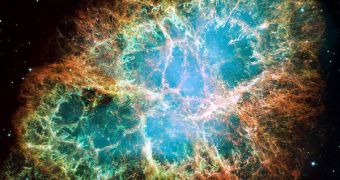While peering inside a neighboring galaxy group, located some 12 million light-years away, astronomers discovered the signature of an elusive supernova explosion, which took place in the M82 galaxy. The formation is among the closest to Earth discovered over the past five years, but experts say that the reason the supernova is not visible to astronomers yielding regular telescopes is the fact that it's surrounded by massive clouds of dust and cosmic gas. This makes picking it up with any observatory other than radio ones impossible, Space informs.
The object, which was named SN 2008iz, is located inside a powerful star-forming region inside M82. The galaxy in itself is much smaller than the Milky Way, but that doesn't stop it from being very active, as far as creating young stars go. Astronomers have also learned the fact that the area with the most activity is at the very core of the galaxy, within a few hundred light-years from the black hole around which all the stars revolve. According to estimates, the region is responsible for creating more stars than the Milky Way does as a whole.
M82 has earned among astronomers the nickname “exploding galaxy,” mostly because it looks like it's being ripped to pieces, when observing it in the optical and infrared spectra. This appearance is due to the large number of massive stars that explode within the formation, but such an explosion was not recorded for more than 25 years. Experts were starting to wonder what had happened that prevented any stars from exploding.
By using the Very Large Array (VLA) of the National Radio Astronomy Observatory, in New Mexico, experts from the Max-Planck-Institut fur Radioastronomie in Bonn, Germany, led by Andreas Brunthaler, learned that the reason why everything was “silent” was because they were using the wrong wavelengths to look for the blasts. With the help of the VLA's 27 identical 25-meter telescopes, the researchers had already photographed the area in radio wavelengths and, on April 8th, Brunthaler noticed some differences between the current picture and older ones.
“I then looked back into older data we had from March and May last year, and there it was as well, outshining the entire galaxy!” he said of the find. This type of formations can only be identified when a massive star collapses its core, generating either a black hole, or a fast-spinning neutron star. The shock waves from the explosion hit the matter that the star had shed before collapsing, and generate radio emissions, which can penetrate the thick clouds of cosmic gas and dust around the core of M82.
“This cosmic catastrophe shows that using our radio telescopes we have a front-row seat to observe the otherwise hidden universe,” University of Nijmegen/ASTRON expert Heino Falcke added. In order to photograph the explosion, the team used the Very Long Baseline Array (VLBA), the VLA, the Green Bank Telescope, in the US, and the Effelsberg 100-meter telescope in Germany, all interconnected with interferometry. They noticed that the ring-like structure that was generated by the blast was moving at about four percent the speed of light, which is well within the range supernova explosions move.

 14 DAY TRIAL //
14 DAY TRIAL //